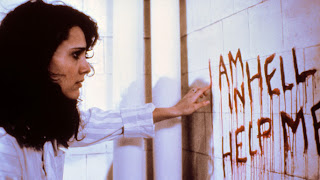Click here for a list of all other films reviewed and considered for this October 2012 series of horror reviews.
 |
| Yes, and that's about how you might feel while watching this film. |
Hellbound:
Hellraiser II comes across as if screenwriter Peter Atkins placed elements
of Hellraiser on a board on the wall,
threw darts at it while wearing a blindfold, and whatever he hit earned its
place in the sequel. This film is a total mess. It is not only incoherent on
its own terms, but barely meshes with its predecessor in any meaningful way. It
retains the premise and the majority of the main characters, but loses any
sense of plotting, cause and effect, and basic storytelling.
Clive Barker, who created the original story and directed
the first picture, stayed on as producer of the sequel. He placed Tony Randel,
who worked as an editor on Hellraiser,
in the director’s chair. If Barker’s intention was to recapture the spirit of
the film he made, then the final product is an utter failure. If, on the other
hand, his only goal was to revisit the creative production design, then he
succeeded because that’s all Hellbound
has going for it.
The action immediately follows on from the first film.
Kirsty (Ashley Laurence) has been admitted to a psychiatric hospital following
her ravings about demons from another dimension torturing and killing her
father and stepmother. By remarkable coincidence, Dr. Channard (Kenneth
Cranham), the man who runs the hospital, is something of an aficionado of this
alternate dimension. You might say he has an obsession with it. His patients
have all gone mad trying to solve the puzzles that unlock the gateway he seeks.
He keeps memorabilia in his home, including an old photograph of the man who
eventually became Pinhead (Doug Bradley), the lead cenobite.
In the first film, the cenobites were supporting players.
They used the humans who entered their world as playthings, torturing them into
oblivion. In the sequel they appear more often and Pinhead has more lines.
Following this film, his popularity grew immensely and he became the focus of
the later sequels. But for now, Julia (Clare Higgins) takes center stage just
as Uncle Frank did before. I’m not even sure I could follow the plot well
enough to explain how it is Julia went, in the first film, from being a somewhat
reluctant participant in Frank’s twisted world, to now being like the queen
bee. And when she meets Frank, with whom she had what might have been the
greatest sex in the history of the sport because what else could lure a woman
to bring murder victims home to her zombie boyfriend, it’s as if there exists a
history of animosity and distrust between them.
Meanwhile Kirsty wants to enter the alternate dimension
believing her father to be lost there. This turns out to be a complete red
herring. Andrew Robinson didn’t sign on for the sequel. Tiffany (Imogen
Boorman), a young girl from the hospital who happens to be adept at solving
puzzles, helps Dr. Channard down the rabbit hole. She and Kirsty work together
to defeat Julia, thwart the cenobites, and escape back to the real world. That’s
about all I was able to gather from the film as far as plot goes. So much of it
is nonsense.
As so often occurs with sequels, Hellbound had a much larger budget than the first film. Composer
Christopher Young expanded on his musical score, making it a little more
bombastic without adding any texture. The set design is more immense and better
designed although under-utilized. The same makeup and effects team worked on
creating the look of the cenobites, which remains fresh and original. They get
much more screen time to show off the time and effort that much have gone into
plastering the actors in makeup that makes them look demonically frightening.
The design of hell as a labyrinth is well-intentioned, but it doesn’t really go
anywhere. And despite some great looking effects, there are some moments that
are downright goofy looking, or maybe they’re just a little dated now.
The overall effect of the movie is that it exists as an
excuse to display gruesome effects and gory images. If anyone involved in the
making of it, either at the story stage or in the editing room after principal
photography wrapped, had wanted to make something engaging for viewers, they
would have had to throw everything out and start over. Somewhere in these ideas
is a decent idea for a very good horror film. Clive Barker and the team he
assembled to make this massive failure did not manage it.



No comments:
Post a Comment